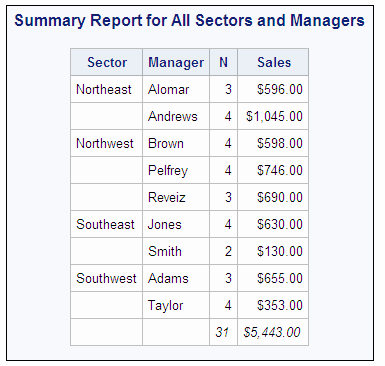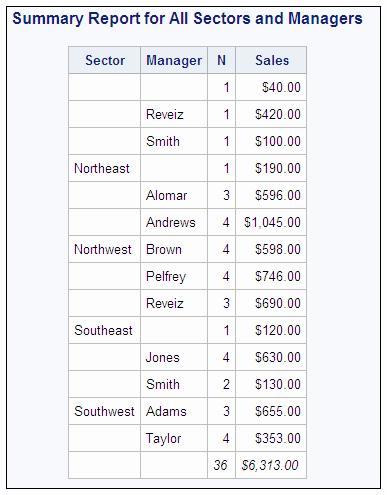REPORT Procedure
- Syntax

- Overview
- Concepts
- Using
- Results
- Examples
 Selecting Variables for a ReportOrdering the Rows in a ReportUsing Aliases to Obtain Multiple Statistics for the Same VariableConsolidating Multiple Observations into One Row of a ReportCreating a Column for Each Value of a VariableDisplaying Multiple Statistics for One VariableStoring and Reusing a Report DefinitionCondensing a Report into Multiple PanelsWriting a Customized Summary on Each PageCalculating PercentagesHow PROC REPORT Handles Missing ValuesCreating and Processing an Output Data SetStoring Computed Variables as Part of a Data SetUsing a Format to Create GroupsSpecifying Style Elements for ODS Output in the PROC REPORT StatementSpecifying Style Elements for ODS Output in Multiple StatementsUsing Multilabel FormatsUsing the WIDTH= and CELLWIDTH= Style Attributes with PROC REPORT
Selecting Variables for a ReportOrdering the Rows in a ReportUsing Aliases to Obtain Multiple Statistics for the Same VariableConsolidating Multiple Observations into One Row of a ReportCreating a Column for Each Value of a VariableDisplaying Multiple Statistics for One VariableStoring and Reusing a Report DefinitionCondensing a Report into Multiple PanelsWriting a Customized Summary on Each PageCalculating PercentagesHow PROC REPORT Handles Missing ValuesCreating and Processing an Output Data SetStoring Computed Variables as Part of a Data SetUsing a Format to Create GroupsSpecifying Style Elements for ODS Output in the PROC REPORT StatementSpecifying Style Elements for ODS Output in Multiple StatementsUsing Multilabel FormatsUsing the WIDTH= and CELLWIDTH= Style Attributes with PROC REPORT
Example 11: How PROC REPORT Handles Missing Values
| Features: |
PROC REPORT statement options: MISSING COLUMN statement: with the N statistic |
| Other features: |
TITLE statement |
| Format: | $MGRFMT |
Details
This example illustrates
how PROC REPORT handles missing values for group (or order or across)
variables with and without the MISSING option. The differences in
the reports are apparent if you compare the values of N for each row
and compare the totals in the default summary at the end of the report.
Program with Data Set with No Missing Values
libname proclib
'SAS-library';
options fmtsearch=(proclib);
data grocmiss; input Sector $ Manager $ Department $ Sales @@; datalines; se 1 np1 50 . 1 p1 100 se . np2 120 se 1 p2 80 se 2 np1 40 se 2 p1 300 se 2 np2 220 se 2 p2 70 nw 3 np1 60 nw 3 p1 600 . 3 np2 420 nw 3 p2 30 nw 4 np1 45 nw 4 p1 250 nw 4 np2 230 nw 4 p2 73 nw 9 np1 45 nw 9 p1 205 nw 9 np2 420 nw 9 p2 76 sw 5 np1 53 sw 5 p1 130 sw 5 np2 120 sw 5 p2 50 . . np1 40 sw 6 p1 350 sw 6 np2 225 sw 6 p2 80 ne 7 np1 90 ne . p1 190 ne 7 np2 420 ne 7 p2 86 ne 8 np1 200 ne 8 p1 300 ne 8 np2 420 ne 8 p2 125 ;
proc report data=grocmiss nowd headline;
column sector manager N sales;
define sector / group format=$sctrfmt.; define manager / group format=$mgrfmt.; define sales / format=dollar9.2;
rbreak after / dol summarize;
title 'Summary Report for All Sectors and Managers'; run;
Program Description
Specify the format search library.The SAS system option FMTSEARCH= adds the SAS library
PROCLIB to the search path that is used to locate formats.
Create the GROCMISS data set. GROCMISS
is identical to GROCERY except that it contains some observations
with missing values for Sector, Manager, or both.
data grocmiss; input Sector $ Manager $ Department $ Sales @@; datalines; se 1 np1 50 . 1 p1 100 se . np2 120 se 1 p2 80 se 2 np1 40 se 2 p1 300 se 2 np2 220 se 2 p2 70 nw 3 np1 60 nw 3 p1 600 . 3 np2 420 nw 3 p2 30 nw 4 np1 45 nw 4 p1 250 nw 4 np2 230 nw 4 p2 73 nw 9 np1 45 nw 9 p1 205 nw 9 np2 420 nw 9 p2 76 sw 5 np1 53 sw 5 p1 130 sw 5 np2 120 sw 5 p2 50 . . np1 40 sw 6 p1 350 sw 6 np2 225 sw 6 p2 80 ne 7 np1 90 ne . p1 190 ne 7 np2 420 ne 7 p2 86 ne 8 np1 200 ne 8 p1 300 ne 8 np2 420 ne 8 p2 125 ;
Specify the report options. The
NOWD option runs PROC REPORT without the REPORT window and sends its
output to the open output destinations. HEADLINE underlines all column
headings and the spaces between them.
Specify the report columns. The
report contains columns for Sector, Manager, the N statistic, and
Sales.
Define the group and analysis variables. In this report, Sector and Manager are group variables.
Sales is, by default, an analysis variable that is used to calculate
the Sum statistic. Each detail row represents a set of observations
that have a unique combination of formatted values for all group variables.
The value of Sales in each detail row is the sum of Sales for all
observations in the group. In this PROC REPORT step, the procedure
does not include observations with a missing value for the group variable.
FORMAT= specifies formats to use in the report.
define sector / group format=$sctrfmt.; define manager / group format=$mgrfmt.; define sales / format=dollar9.2;
Program with Data Set with Missing Values
proc report data=grocmiss nowd headline missing; column sector manager N sales; define sector / group format=$sctrfmt.; define manager / group format=$mgrfmt.; define sales / format=dollar9.2; rbreak after / dol summarize; run;

